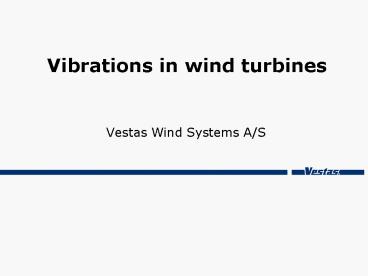Vibrations in wind turbines - PowerPoint PPT Presentation
1 / 13
Title:
Vibrations in wind turbines
Description:
Vibrations is cyclic movements of points on a structure. Complex representation makes mathematical ... Clamped-Free (Cantilever Beam) 8. Torsional vibrations ... – PowerPoint PPT presentation
Number of Views:361
Avg rating:3.0/5.0
Title: Vibrations in wind turbines
1
Vibrations in wind turbines
- Vestas Wind Systems A/S
2
Agenda
- Linear SDOF systems
- Effects of input forces
- Linear MDOF systems
- Example on effects
- Continuous systems / boundary conditions
- Torsional vibrations
- Wind turbine drive trains
- Rotor disk modelling
- Practical use / real problems
- The presentation is thought as an appetizer, and
will not cover formulas and development of theory
3
Vibrations
- Vibrations is cyclic movements of points on a
structure - Complex representation makes mathematical
handling easier - Out of phase part represents the amount of
damping in a structure. - The movements can be forced or free.
- Frequency is measured in Hz cycles/sec, or
often angular velocity.
4
Damping
- Theoretically structures can be shown without
damping. - Real structures will always be more or less
damped. - Damping is Energy loss
- Undamped structures will move forever.
- Damped vibrations will die out after some time.
- Typical damping for metallic structures is a
damping ratio of 0.01 - Typical rubber damping is 0.1 to 0.2.
- Bolted structures can be anything depending on
friction or other energy losses
5
Linear SDOF system
- Developing the differential equations show one
specific eigenvalue for the system. - Eigenvalues show up as a peaks in frequency
response plots. - Response on input force depend upon frequency.
- Operation below 1.4 times eigenvalue causes
amplification of forces. - Operation above reduces forces
f00.4, f01.01, f01.6
6
Linear MDOF systems
- If more than one sprint/damper/mass is present in
a system, we are talking of MDOF systems - The result are a more complex response, where
some frequencies are amplified, and some are
reduced.
7
Continous systems / beams
Free-Free
Clamped-Clamped
(Fixed-Fixed)
Simply Supported at
Both Ends
Clamped-Free
(Cantilever Beam)
8
Torsional vibrations
- Like linear system, rotational systems have
resonances. - Behaviour of torsional vibrations is identical
with linear systems, but more complex to get the
feeling of. - Combinations of linear and torsional systems is
common in the modelling of any system.
9
Wind turbine drive train
- A turbine drive train is a combination of 3 beams
and some rotational elements. - Blade (beam) bending induces torque on the
rotational DOFs - Using traditional tools like VTS regards the
drive train as two DOFs one at each end. - Different rpm must be corrected for before
solving any equations - Taking a more detailed approach includes at
minimum modelling of each stage inside the
gearbox, and brake disk and coupling outside the
gearbox. - Detailed modelling needs to take rpm for each
component into account.
10
Rotor disk modelling
- Simple modelling regards the drive train as two
rotating DOFs. - Medium advanced step in modelling is rotor disk
modelling with several DOFs. - This can have as many elements as desired
extreme one for each wheel in the drive train. - State of the art modelling is MBS, where each
element is given 6 DOF, and any nonlinearities
between elements is taken into account.
11
Practical use
- When force is given in at frequencies close to
resonances in the turbine, oscillations will
build up. - Rule of thumb
- 0 to 10 Hz results in failures within short time
- 10 to 100 Hz results in long term fatigue
- gt 100 Hz results in audible noise.
- Exciting forces can be wind, waves, P, 3P,
gearbox tooth meshes
12
Failure mechanisms
- VTS takes frequencies below 10 Hz into account.
Good agreement between measured and simulated
loads are seen. - Frequencies 10 to 100 Hz, may influence bearing
and tooth failures. Research is being made for
clarification of this. - Frequencies above 100 Hz are often seen as
tonality at tooth mesh frequencies, where
penalties are given to turbines if tonal noises
occur. - Future state of the art will probably be MBS
modelling.
13
Questions?































